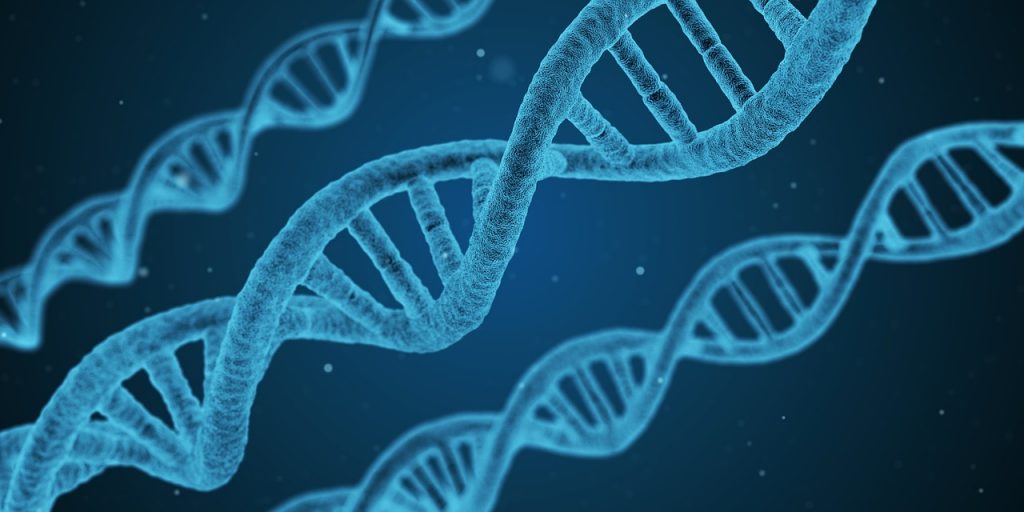The instructions our bodies need to grow and function are contained in our genes. These instructions are made up of tiny structures called nucleobases. There are four types of nucleobases in DNA: adenine (A), cytosine (C), guanine (G), thymine (T). By putting these four nucleobases in different orders and patterns, this writes the instructions for our body.

Some of the genes contain long sections of repeating ‘CAG” instructions, called CAG tracts. Everyone has repeating CAG tracts in these genes, but once they are over a certain length they can lead to disease. Some ataxias are caused by this type of mutation, including SCA1, SCA2, SCA3, SCA6, SCA7 and SCA17. These are often called polyglutamine expansion disorders. This is because “CAG” gives the body instructions to make the amino acid glutamine. You can read more about what is polyglutamine expansion in our past Snapshot about that subject.
For each disorder caused by a CAG expansion mutation, the number of times the CAG is repeated in a particular gene will determine whether someone will develop the disease. Repeat lengths under this number will not cause symptoms and repeat lengths over the threshold will usually lead to ataxia. When someone undergoes genetic testing for ataxia, doctors will be able to tell them the length of these CAG tracts and whether they have a CAG repeat number in one of these genes that is over the threshold. This table gives a summary of different CAG expansion mutations that can lead to ataxia and how the length of the repeat affects age of onset.
| Affected Gene | Normal Repeat Size |
Disease Repeat Size |
|
| SCA1 | ATXN1 | 6-44 | 39-88 |
| SCA2 | ATXN2 | 15-31 | 36-77 |
| SCA3 | ATXN3 | 12-40 | 55-86 |
| SCA6 | CACNA1A | 4-18 | 21-33 |
| SCA7 | ATXN7 | 4-35 | 37-306 |
| SCA12 | PPP2R2B | 4-32 | 66-78 |
| SCA17 | TBP | 25-42 | 46-63 |
For SCA1, SCA2, SCA3, SCA6, and SCA7; longer CAG tracts are associated with earlier onset.
For SCA12, it is hard to predict the age of onset based on repeat length as SCA12 is so rare. Some individuals with long repeats don’t develop ataxia. One study found that longer CAG tract lengths are associated with earlier onset but that it does not affect the severity of symptoms.
For SCA17, Longer CAG tracts have separately been associated with an earlier age of onset and more severe cerebellar atrophy.
In general, people with longer repeat lengths in ataxia genes are likely to present with ataxia symptoms earlier in life. However, it is important to remember that there are many other factors involved. Other genes may have mutations that either worsen the progression of ataxia or protect against more severe symptoms. Therefore, in individual people, the length of the repeat is not always enough information to determine when that person will start showing symptoms, or how severe these symptoms will be.
If you would like more information about the genetic causes of SCAs, including information about genetic testing and what CAG repeat length might mean, take a look at these resources by the National Ataxia Foundation.
Snapshot written by Anna Cook and edited by Larissa Nitschke.
References
Cummings, C. J. & Zoghbi, H. Y. Fourteen and counting: unraveling trinucleotide repeat diseases. Hum. Mol. Genet. 9, 909–916 (2000).
Tezenas du Montcel, S. et al. Prediction of the age at onset in spinocerebellar ataxia type 1, 2, 3 and 6. doi:10.1136/jmedgenet-2013-102200
Johansson, J. et al. Expanded CAG repeats in Swedish spinocerebellar ataxia type 7 (SCA7) patients: effect of CAG repeat length on the clinical manifestation. Hum. Mol. Genet. 7, 171–176 (1998).
Margolis, R. L., Holmes, S. E., Srivastava, A. K., Mukherji, M. & Sinha, K. Spinocerebellar Ataxia Type 12. GeneReviews® (University of Washington, Seattle, 1993).
Choudhury, S. et al. Clinical Characterization of Genetically Diagnosed Cases of Spinocerebellar Ataxia Type 12 from India. Mov. Disord. Clin. Pract. 5, 39–46 (2018).
Reetz, K. et al. CAG Repeats Determine Brain Atrophy in Spinocerebellar Ataxia 17: A VBM Study. doi:10.1371/journal.pone.0015125
Nethisinghe, S. et al. Complexity of the Genetics and Clinical Presentation of Spinocerebellar Ataxia 17. Front. Cell. Neurosci. 12, 429 (2018).









